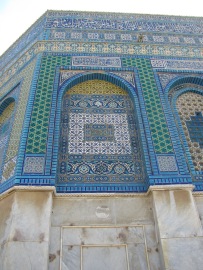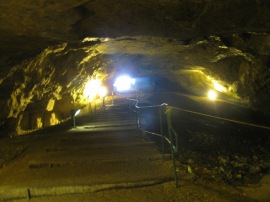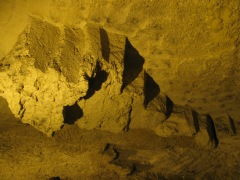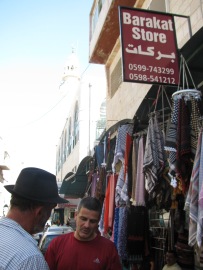Israel, Palestine
At breakfast on our 4th day, we were informed that we were to spend the day walking around Old Jerusalem again. After yesterday we were very happy about the prospect of being able to find shade regularly, what a difference a day makes.
This time we walked down the Kidron Valley below the Beautiful Gate and past Absalom’s Pillar on our way to David’s City. This is the original part of Jerusalem where the first lot of walls were built to surround the Temple site and his palace and was only about 10 acres all up, I think. This area is now been taken over by the Jerusalem Walls National Park and is a popular tourist destination.
Ian had warned us that we were to walk through Hezekiah’s Tunnel, starting from David’s City and ending at the Pool of Siloam, last night. I was quite nervous about this idea of wandering through a narrow, unlit tunnel for 500 metres but I gave myself a stern talking to and resolved to be a big girl and join the rest of them. After all, Dennis was determined to do it (even with his claustrophobia issues) and even the older women on the tour were keen. Hazel was 80 and she was planning to go. Hezekiah’s Tunnel was dug underneath the City of David before 701 BC, during Hezekiah’s reign of Judah (2 Kings 20). He was worried about a siege of Jerusalem by the Assyrians so he blocked the source of the water, the Gihon Springs (2 Chron 32), which were outside the City Walls and redirected the water to flow through an underground aqueduct to the Pool of Siloam. The depth of the water varies in places from 100mm through to 1 metre deep and flows surprisingly rapidly. Before we were due to descend the steps to the tunnel entrance, we were first shown a 3D, DVD about the construction of the Tunnel and the people responsible for it. It was while viewing this that I finally came to the firm conclusion that there was NO WAY that I was going down there! 533 metres long, about three-quarters of the time you couldn’t stand up straight, walking in water, just a torch to light the way and many times you couldn’t see the person in front of you – that was the impression the DVD gave me. It was one of the few times that everyone was given permission to wear shorts. (Our tour guides were careful for us to observe modest dress standards while walking around Jerusalem and the other sensitive religious sites, so we wouldn’t unnecessarily offend others). Once I had confirmed that the group would be returning to the Visitor Centre where I was, I sat down and waited patiently and was actually joined by one other tour member. When Dennis did return he was so pleased with himself. “Oh, you should have come, you would have loved it! It was so interesting!” etc, etc. My impression from the DVD was correct, but apparently I would have loved it.
Dennis and I met an elderly, Italian man while we were eating out in a bagels shop at lunchtime. With only a little English on his part, no Italian on our part, a little French between us and with many hand signals we had quite a wide-ranging conversation with him for 30 minutes! It’s always to nice to see positive reactions when people learn we are Kiwis.
Next up we were off to see if we would be allowed up onto the Temple Mount. Right beside the security desks into the Western Wall there is a small, locked gate that leads you up to the Mount. Muslims have built a gold covered Dome up where the Second Temple used to be, they believe that Mohammed ascended to heaven from that spot. Non-Muslims are allowed to enter this holy site for 1.5 hours in the morning and 1 hour in the afternoon so Ian wanted us to be first in the queue this afternoon. He warned us that on some days the gate doesn’t open on time but the hour still starts counting down at 1p.m. so we were to wait quietly for 30 minutes from 12.30p..m. and see what happened today. Once again the temperature was over 40 degrees and it was very uncomfortable standing in the sun, waiting. 1p.m. came and went but thankfully it was only a few minutes extra waiting until the gate swung open and we were ushered into the security checking area. If anyone wore or had Christian materials or symbols on their person these were immediately removed and placed in an open cupboard outside the Muslim area. There was no guarantee that they would be there when we returned as this was open to the public. Any water in our water bottles had to be poured out before entering the site but we could replenish them once inside. Dennis, Vic ( who is about 70) and I slowly walked up the long ramp onto the Temple Mount itself. We were chatting away when as I came close to three “security” men, one started yelling at me in Arabic. I really didn’t know what he was on about and Vic suggested to me that maybe my short-sleeved shirt had upset him. It has a V-necked shape but does not reveal a heaving bosom, so I had thought it was pretty modest. The screaming skull thrust a shawl wrapped in plastic at me and demanded 20 shekels. I tried to explain that Dennis was following and he had the money but he kept up his yelling throughout. Thinking quickly I wondered if it was wiser to wait until Dennis had paid for the shawl before opening the packet, but then that might look as if I was ignoring him or taking out the shawl before the coins were given and thus giving the impression I was stealing it! Decisions, decisions….. The still screaming man, now almost foaming at the mouth, grabbed the still wrapped shawl from my hand, tore it open and thrust it under my nose and gave me the impression I should don it quickly, which I did. What’s with all the yelling? All the while this was going on, Vic was getting similar treatment. He was wearing long shorts, the ones that come below the knee and the Muslin guy would not allow him entry, saying he must have his ankles covered. Eventually Vic had to buy a shawl as well and wear it as a skirt with the aid of some safety pins. Dennis was in trouble as well, just back around the corner and that was why he hadn’t turned up to pay for my shawl! This was partly his fault though, first of all they were worried about his black hat as it looked like it may have been Jewish Orthodox. After he assured them that it was his and had come all the way from NZ they were satisfied with that but although Dennis had packed a pair of trousers in the backpack he had forgotten to change into them so they were incensed about that. While Vic and I were being screamed at around the corner, Dennis was quickly climbing into his trousers, over top of his shorts, looking a wee bit bashful. We finally made it and joined the rest of the group. We noticed other people with shorter shorts than Vic who hadn’t been censored, ah well…It was great to have Chris explain how this area would have looked in the time of Solomon’s temple. As Christians we were not allowed to enter the al-Aqsa Mosque but we could admire it and the Muslim themed architecture of the nearby Dome of the Rock, which are beautiful. The area called the Temple Mount is a much disputed area between the Jewish and Islamic religions. Jews call the site Haram and regard it as holy because it was where Issac was bound, the two Temples once stood here and it will be the site of the third and final Temple. Muslims call it Ash-Sharif and regard it as holy because Mohammad ascended to heaven from the Rock and they built the Dome, which faces Mecca, in 637 AD to cover it. Chris and Ian reminded us of some of the occasions that the site of the Temple Mount is talked about in Scripture; Abraham and Isaac on Mt. Moriah (Gen 22), the threshing floor of Araunah (2 Sam24), preparations for the Temple (1 Chron22), building of the Temple (2 Chron), destruction of first Temple (2 Chron 36), Temple rebuilt (Ezra) and then Jesus in the Temple, etc. I was surprised how big the area of the Temple Mount is, once you were inside the walls.
Next we walked to a place known as The Garden Tomb. This is an alternative possible site to the Church of the Holy Selpchure, where some believe the tomb where Jesus’ body was laid, is. It is just outside the old city walls and just along a bit may have been where the crucifixion took place. As I said there is disagreement between the two sites but I did think this location was the more calm and restful of the two. It is still kept as a garden and even if you weren’t worried about whether it is or is not the actual site (I wasn’t) it was a lovely quiet place to contemplate the events that we celebrate each Easter. I kept thinking about what Jesus said to doubting Thomas, “Blessed are those who have not seen and yet have believed” in this context rather than worry about exactly where it all may have happened.


Then back to the Rivoli Hotel for another delicious meal followed by a devotion led by Chris and a great night’s sleep. And so endeth Day 4.
Before leaving Jerusalem the following day, we walked the short distance to Solomon’s Quarries (also known as Zedekiah’s Cave). Ian assured me I would be able to walk upright all the way through so I joined everyone else as well. And what an amazing place! We walked through a little gate under the Old Walls and immediately found ourselves in this huge cathedral-like space. It is a 5-acre underground limestone quarry that runs the length of five city blocks under the Muslim Quarter. It was carved over a period of several thousand years and it is extraordinary! From entrance to the furthest point, the cave extends about 200m, its maximum width is about 100 m and it’s depth is generally about 9 m below the street level. It varies in height inside but is often more than 3 or 4 metres. Herod the Great used the main quarry at Zedekiah’s Cave for building blocks in the renovation of the Temple and its retaining walls, including the Western Wall. It was amazing to consider that we were standing directly underneath where we had been walking for the last two or three days. The cave is still being excavated of rubble so who knows where it will end up.
We alighted Shadi’s bus and drove to the Israeli Museum. I knew that however long we had planned there it would not be long enough for Dennis, and so it was. There is a huge model of Jerusalem as it was at the time of 70 AD before the Romans got their hands on it, which was very helpful to understand the dimensions of the city back then. The model was really impressive, 2,000 square metres and built using a 1:50 scale. It is based mainly on Josephus’ accounts but also other writers around that time and also ongoing archeology. Inside the Museum there are all the usual exhibits that we could have enjoyed for days but we were keen to see the Isaiah Scroll in the specially built Shrine of the Book on the same site, before our time was up. This building was intriguing as well, it was shaped to resemble one of the pottery jar lids, that the scroll was hidden in. The shrine is built as a white dome, covering a structure placed two-thirds below the ground and is reflected in a pool of water that surrounds it.

Solomon’s Portico on the right inside the Temple Mount, then David’s City running down the slope, with the rest of Jerusalem
Back on the bus and in less than 20 minutes we were taken to the West Bank border post that the Israeli settlers use. The traffic is less dense on this site and there’s virtually no queuing so it makes entry into the West Bank quicker and easier. It is so barren around here, no flowers other than bouganvilias. Lots of olive groves though, the trees are severely pruned so that they are kept low for picking and have huge trunks so must be very old. Citrus, figs, loquats and grape vines all flourished here, as well in the private gardens, even though they were covered in a thick layer of white dust. Once again Ian and Chris shouted the whole group lunch, this time in a Palestinian restaurant. Another delicious meal. Dennis and I sat outside in the little strip of shade next to the shop and were stared at in wonder by the passers-by as it must have been 45 degrees. There seemed to be plenty of residential building going on in both the Palestinian and Israeli areas.
After lunch we visited Herodium. In 40 BC, Herod fled to Masada, but on the way he fought with the Parthians and emerged victorious. According to the Roman Jewish historian Josephus, he “built a town on that spot in commemoration of his victory, and enhanced it with wonderful palaces… and he called it Herodium after himself.” Herod’s tomb is also at this site in a grand mausoleum. We walked up a rather steep hill to view the remains of his palace here and were totally amazed to learn that Herod had this mountain built especially for him by slaves. Originally there was a small hill here but he had it raised by 200 metres and shaped to resemble a woman’s breast, as you do. He certainly was a nasty piece of work, he was so concerned that no one would mourn his death that he put in his will when he died, 70 distinguished men must be killed so that the displays of grief that he craved would take place. Thankfully once he did die his family did not follow these instructions.

Looking down on part of the Israeli Army base. The majority of olive groves used to be owned by people who live in Bethlehem – they are very cross to not be allowed to tend them, now that they are trapped inside the Seclusion Wall
From this height we were shown the fields where the shepherds would have been with their sheep and goats on the evening that the angels came to announce the birth of the Son of God. I found it astonishing to see shepherds still walking with their flocks in this barren land. All the Christmas cards depict lovely green pastures but the reality is brown, dry land with not a lot for these animals to eat. Today at the base of this hillside there is an extensive Israeli army base set up, another reminder to us that there is real tension here between the Palestinians on the West Bank and Israel.

Shepherds tend sheep and goats in the one flock, reminds me of the parable Jesus told about separating sheep from goats.
Next stop was Bethlehem, where we were given a few hours of free time from the tour group. I don’t really know what I was expecting but it was not what I found. I admit I’m pretty ignorant about the political situation over here but I was unaware that Bethlehem was even in the Palestinian area! It’s a dry and rocky terrain, with steep streets. All the houses, shops, churches and mosques are built of the local limestone with no variation of colour anywhere. We walked up to the most visited tourist attraction in Bethlehem, the supposed site of the inn where Joseph and Mary stayed in the stable area. It’s now a Church and there were crowds of tourists lining up to go inside. Not really an attraction for us. We wandered off in the opposite direction to take in the sights of the busy city streets. Once again it is fun to just wander around with a bit of time to look in the shops and speak to the very friendly shop keepers. We felt very safe and enjoyed animated conversations. Several of them got quite excited to find that we are Kiwis and wanted us to set up a business with them, sending back paua shells! We were puzzled initially until it was pointed out to us all the items with mother of pearl and paua shell decorations in the shops. They had artificially cultivated shell but the natural NZ stuff is the best. Ah… Dennis’ eyes shone with the idea of another business.

This 80-year-old cobbler was still hard at work, he didn’t understand one word of English but a friendly local became our translator
We arrived at our Hotel for the night, a very upmarket affair with air conditioning in our rooms. Yah, we were all wilting in this continual heat, another 40+ degrees again today. Even the breezes are warm. Our evening meal was delicious but truth be told we preferred the personal service we had enjoyed back in the Hotel in Jerusalem. After dinner, in place of our usual time of devotion and singing, we were privileged to meet a special guest. He is a Palestinian Christian fellow who has lived in Bethlehem all his life. He gave his testimony to us about how and when he became a Christian and his life living behind the Seclusion Wall the Israelis have erected about 10 years ago. It was so moving to listen to this softly spoken man, who has been beaten and imprisoned for his faith in the Lord Jesus Christ many times and who has been repeatedly warned not to witness to others. His response to that is “I cannot do anything else, no matter what happens.” He is a very humble man and the entire group were reduced to tears. Talking about the political situation he urged us to value our passports as he would love to have one himself. He has family living in Jerusalem just a six kms away but is prevented from visiting them because of the Wall, something that is such an everyday thing for us to do (to decide if we drive a few kilometres to visit friends and relations) even this is denied him and the others living here in Bethlehem. It was amazing to hear all this and consider that we are brothers and sisters in Christ yet we are so blessed, through no merit in ourselves. This evening has been the highlight of our Israeli tour.


























